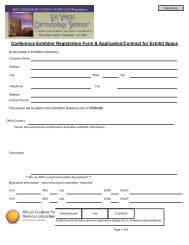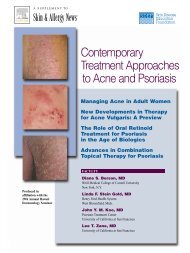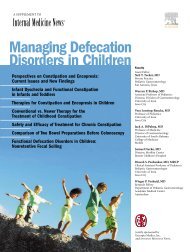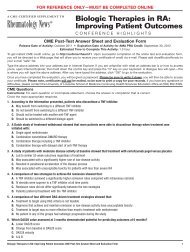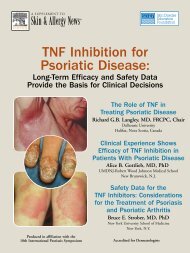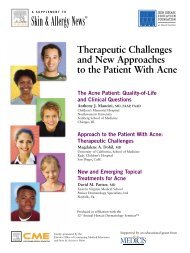Overview Of Psoriasis - Global Academy for Medical Education
Overview Of Psoriasis - Global Academy for Medical Education
Overview Of Psoriasis - Global Academy for Medical Education
You also want an ePaper? Increase the reach of your titles
YUMPU automatically turns print PDFs into web optimized ePapers that Google loves.
A SUPPLEMENT TO<br />
Skin & Allergy News®<br />
Update on the New Biologic<br />
Therapies <strong>for</strong> <strong>Psoriasis</strong><br />
Kenneth B. Gordon, MD<br />
Associate Professor of Medicine<br />
Division of Dermatology<br />
Loyola University <strong>Medical</strong> Center<br />
Chicago<br />
Topic Areas<br />
Alice B. Gottlieb, MD, PhD<br />
W.H. Conzen Chair in Clinical Pharmacology<br />
Director of the Clinical Research Center<br />
Professor of Medicine<br />
University of Medicine and<br />
Dentistry of New Jersey-<br />
Robert Wood Johnson <strong>Medical</strong> School<br />
New Brunswick<br />
<strong>Overview</strong> of <strong>Psoriasis</strong>: Rationale<br />
<strong>for</strong> the Use of Biologic Therapy<br />
<strong>Overview</strong> of Biologic Therapies<br />
in the Treatment of <strong>Psoriasis</strong><br />
Integrating the New Biologic<br />
Therapies Into Clinical Practice<br />
Jointly sponsored by<br />
Excerpta Medica, Inc.,<br />
and SKIN & ALLERGY NEWS
®<br />
Skin & Allergy News<br />
Group Publisher/<br />
General Manager<br />
Alan J. Imhoff<br />
Vice President,<br />
<strong>Medical</strong> <strong>Education</strong> &<br />
Business Development<br />
Sylvia H. Reitman<br />
Manager, <strong>Medical</strong> <strong>Education</strong><br />
Jenny R. McMahon<br />
National Account Manager<br />
Cheryl J. Gromann<br />
Graphic Design<br />
Lehner & Whyte, Inc.<br />
Production Manager<br />
Judi Sheffer<br />
Update on the New Biologic<br />
Therapies <strong>for</strong> <strong>Psoriasis</strong><br />
<strong>Overview</strong> of <strong>Psoriasis</strong>: Rationale<br />
<strong>for</strong> the Use of Biologic Therapy 3<br />
<strong>Overview</strong> of Biologic Therapies<br />
in the Treatment of <strong>Psoriasis</strong> 4<br />
Integrating the New Biologic<br />
Therapies Into Clinical Practice 9<br />
Conclusions 9<br />
References 10<br />
CME Test and Post-Test Evaluation 11<br />
Faculty<br />
Kenneth B. Gordon, MD<br />
Associate Professor of Medicine<br />
Division of Dermatology<br />
Loyola University <strong>Medical</strong> Center<br />
Chicago<br />
Alice B. Gottlieb, MD, PhD<br />
W.H. Conzen Chair in Clinical Pharmacology<br />
Director of the Clinical Research Center<br />
Professor of Medicine<br />
University of Medicine and<br />
Dentistry of New Jersey-<br />
Robert Wood Johnson <strong>Medical</strong> School<br />
New Brunswick<br />
The articles in this supplement are based<br />
on presentations made at a continuing<br />
medical education program held March<br />
21-26, 2003, in San Francisco.<br />
The supplement was supported by an<br />
unrestricted educational grant from<br />
It was produced by the medical<br />
education and business development<br />
department of International <strong>Medical</strong><br />
News Group. Neither the Editor of<br />
SKIN & ALLERGY NEWS, the Editorial<br />
Advisory Board, nor the reporting staff<br />
contributed to or reviewed its contents.<br />
The opinions expressed in this<br />
supplement are those of the faculty and<br />
do not necessarily reflect the views of the<br />
supporter or the publisher.<br />
Cover photos courtesy of<br />
Mark Lebwohl, MD.<br />
Copyright 2003 International <strong>Medical</strong><br />
News Group, an Elsevier company. All<br />
rights reserved. No part of this publication<br />
may be reproduced or transmitted in any<br />
<strong>for</strong>m, by any means, without prior written<br />
permission of the Publisher. International<br />
<strong>Medical</strong> News Group will not assume<br />
responsibility <strong>for</strong> damages, loss, or claims of<br />
any kind arising from or related to the<br />
in<strong>for</strong>mation contained in this publication,<br />
including any claims related to the<br />
products, drugs, or services mentioned<br />
herein.<br />
Accreditation<br />
This activity has been planned and implemented<br />
in accordance with the Essential Areas and<br />
Policies of the Accreditation Council <strong>for</strong> Continuing<br />
<strong>Medical</strong> <strong>Education</strong> (ACCME) through the<br />
joint sponsorship of Excerpta Medica, Inc., and<br />
SKIN & ALLERGY NEWS. Excerpta Medica is accredited<br />
by the ACCME to provide continuing medical<br />
education <strong>for</strong> physicians.<br />
Term of Approval: August 2003-August 2004.<br />
Target Audience<br />
This activity has been developed <strong>for</strong> dermatologists<br />
who treat patients with moderate to severe<br />
psoriasis.<br />
<strong>Education</strong>al Needs<br />
For more than 20 years there have been few significant<br />
developments in the treatment of psoriasis.<br />
Today, an entirely new approach to therapy has<br />
been made possible as a result of our increased<br />
understanding of the pathophysiology of psoriasis.<br />
Four new biologic therapy agents are currently<br />
approved or in development to treat psoriasis. Two<br />
agents inhibit the cytokine tumor necrosis factor<br />
alpha (TNF-), and the other two agents target T<br />
cells. This CME activity provides the dermatologist<br />
with an overview of the immunopathology of psoriasis<br />
as well as new in<strong>for</strong>mation about these biologic<br />
therapies.<br />
Learning Objectives<br />
By reading and studying this supplement,<br />
participants should be able to:<br />
• Understand the rationale <strong>for</strong> the use of new<br />
biologic therapies <strong>for</strong> psoriasis;<br />
• Recognize the impact of biologic therapies on<br />
patient-reported outcomes;<br />
• Describe how the new biologic therapies can<br />
be integrated into clinical practice.<br />
Faculty Disclosure of<br />
Funding/Support<br />
As a sponsor accredited by the ACCME,<br />
Excerpta Medica, Inc., requires the disclosure of<br />
any significant financial interest or other relationship<br />
a faculty member has with the manufacturer<br />
of any commercial product.<br />
Kenneth B. Gordon, MD: Grant/Research<br />
Support: Genentech, Amgen, Biogen, Centocor;<br />
Consultant: Genentech, Amgen, Biogen, Centocor.<br />
Alice B. Gottlieb, MD, PhD: Grant/Research<br />
Support: Genentech, Amgen, Biogen, Boehringer<br />
Ingelheim, CellGate, Centocor, Novartis, Wyeth,<br />
XOMA; Consultant: Genentech, Amgen, Biogen,<br />
Boehringer Ingelheim, CellGate, Centocor,<br />
Enanta, Novartis, Roche, Wyeth, XOMA;<br />
Speaker’s Bureau: Amgen, Biogen, Centocor,<br />
Novartis, Wyeth.<br />
Dr. Gordon and Dr. Gottleib discuss the investigational<br />
uses of efalizumab, etanercept, and<br />
infliximab <strong>for</strong> the treament of psoriasis.
<strong>Overview</strong> of <strong>Psoriasis</strong>:<br />
Rationale <strong>for</strong> the Use of Biologic Therapy<br />
Figure 1: Role of T Cells in <strong>Psoriasis</strong> Pathogenesis. 5<br />
<strong>Psoriasis</strong> can have significant<br />
adverse effects on a patient’s<br />
physical, psychological, and<br />
social functioning and touches virtually<br />
every aspect of a patient’s life. Because<br />
the condition often causes absence from<br />
work and can affect the ability to per<strong>for</strong>m<br />
normal work activities, psoriasis<br />
can negatively affect a person’s job and<br />
income. In many cases, an individual’s<br />
family life, social life, and leisure activities<br />
are compromised by psoriasis.<br />
Patients with psoriasis reported reduction<br />
in physical and mental functioning<br />
similar to that of other major medical<br />
diseases. 1 Among the findings of a large<br />
survey conducted by the National<br />
<strong>Psoriasis</strong> Foundation in July 1998 was<br />
that, among respondents 18 to 34 years<br />
of age, 10% reported having contemplated<br />
suicide. 2<br />
<strong>Psoriasis</strong> even impacts one’s sexual<br />
relations, as many people with the<br />
condition shy away from intimate relationships<br />
<strong>for</strong> fear of embarrassment and<br />
rejection. Overall, psoriasis has a negative<br />
effect on patients’ functional<br />
status and well-being, physical symptoms<br />
(including itch), and social<br />
relationships.<br />
Although people with psoriasis experience<br />
severe impairment in functional<br />
health, well-being, and the ability to<br />
per<strong>for</strong>m activities of daily living, many<br />
give up on treatment because conventional<br />
therapies have disappointing efficacy<br />
and are often inconvenient to<br />
administer. 3 There is an unmet need <strong>for</strong><br />
a psoriasis treatment that can improve<br />
these aspects of patients’ lives.<br />
“Nearly half (49%)<br />
of the patients with<br />
severe psoriasis reported<br />
that they were ‘only<br />
somewhat’ or ‘not<br />
at all’ satisfied with<br />
the treatment they<br />
were receiving.”<br />
According to the results of the<br />
National <strong>Psoriasis</strong> Foundation survey,<br />
much of the frustration patients feel is<br />
due to the perceived inadequacy of common<br />
psoriasis treatments. 2 Among<br />
patients with severe psoriasis, 78%<br />
reported feeling frustrated that their<br />
treatment did not work well enough.<br />
Nearly half (49%) of the patients with<br />
severe psoriasis reported that they were<br />
“only somewhat” or “not at all” satisfied<br />
with the treatment they were receiving.<br />
In addition, nearly one third (32%) of<br />
patients thought their treatment was<br />
not aggressive enough. 2<br />
In recent years, our increased understanding<br />
of the role of immunology in<br />
the pathophysiology of psoriasis has led<br />
to the development of biologic therapies<br />
designed to interfere with the underlying<br />
molecular mechanisms at play in the<br />
disease. 4,5 Initially, T cells become activated<br />
in the lymph nodes (Figure 1). 5<br />
The lymph nodes concentrate antigen<br />
drained from the skin and other tissues<br />
and contain high numbers of antigenpresenting<br />
cells (APCs). T-cell activation<br />
is a complex process that requires<br />
interaction between a specific antigen<br />
presented by the APC and a receptor of<br />
the interacting T cell. At present, the<br />
identity of any specific psoriasis antigens<br />
is unknown. Activation depends on<br />
multiple interactions between the T cell<br />
and the APC-antigen complex. The initial<br />
binding is mediated by lymphocyte<br />
function–associated antigen-1 (LFA-1)<br />
on the T cell and intracellular adhesion<br />
molecule-1 (ICAM-1) on the APC. This<br />
is followed by delivery of an antigenspecific<br />
signal and a costimulatory signal,<br />
resulting in T-cell activation. The<br />
resulting expression of surface molecules<br />
on activated T cells leads to<br />
increased binding of the T cells to<br />
endothelial cells. T-cell adherence to the<br />
vascular endothelium is mediated by<br />
specific interactions between their surface<br />
molecules and molecules that are<br />
expressed on the surface of the endothelial<br />
cells. These interactions include the<br />
interaction between LFA-1 on the surface<br />
of the T cells and ICAM-1 on the<br />
surface of the endothelial cells.<br />
Trafficking of T cells from the circulation<br />
into the dermal tissue, and subsequently<br />
into the epidermis, occurs.<br />
T cells then undergo a secondary activation<br />
(reactivation) in the skin when they<br />
encounter APCs displaying the appropriate<br />
specific antigen. 4,5<br />
Update on the New Biologic Therapies <strong>for</strong> <strong>Psoriasis</strong> 3
<strong>Overview</strong> of Biologic Therapies<br />
in the Treatment of <strong>Psoriasis</strong><br />
Numerous biologic therapies that<br />
arrest psoriasis at different steps<br />
are being evaluated (Table 1).<br />
These include agents that interfere with<br />
the interaction between the reactivated T<br />
cells and the keratinocytes in the dermis<br />
by binding postsecretory cytokine tumor<br />
necrosis factor– (infliximab and etanercept);<br />
those that decrease the number<br />
of activated T cells (alefacept); and those<br />
that block T-cell activation, binding, and<br />
trafficking to the dermis and epidermis<br />
(efalizumab). <strong>Of</strong> these agents, alefacept<br />
was approved by the United States Food<br />
and Drug Administration (FDA) in<br />
January 2003 <strong>for</strong> the treatment of psoriasis.<br />
Etanercept is approved <strong>for</strong> use in<br />
juvenile rheumatoid arthritis, psoriatic<br />
arthritis, and rheumatoid arthritis; and<br />
infliximab is approved <strong>for</strong> use in<br />
rheumatoid arthritis and Crohn’s disease.<br />
Both etanercept and infliximab<br />
are in phase III trials <strong>for</strong> the treatment<br />
of psoriasis. Efalizumab is currently<br />
under FDA review (Biologics License<br />
Application submitted) <strong>for</strong> the treatment<br />
of psoriasis.<br />
Assessing the Efficacy of<br />
Biologic Therapies<br />
The FDA has set PASI 75, a decrease of<br />
75% from baseline in the <strong>Psoriasis</strong> Area<br />
and Severity Index (PASI) score following<br />
treatment, as the primary end point<br />
<strong>for</strong> biologic agents in clinical trials <strong>for</strong><br />
psoriasis. The National <strong>Psoriasis</strong><br />
Foundation (NPF) <strong>Medical</strong> Advisory<br />
Board has suggested that PASI 50 (a<br />
50% decrease from baseline in the<br />
<strong>Psoriasis</strong> Area and Severity Index score<br />
after treatment) may be a clinically<br />
more relevant end point. The PASI scale<br />
was developed to quantify the components<br />
of erythema, induration, scaling,<br />
and body surface area (BSA) affected.<br />
Moderate psoriasis is defined as a PASI<br />
score of 12 to 18, and severe psoriasis as<br />
a PASI score of over 18. In comparison,<br />
moderate psoriasis is defined as having<br />
plaques covering 3% to 10% of the<br />
patient’s BSA and severe psoriasis as disease<br />
covering more than 10% of the<br />
patient’s BSA. In viewing the PASI 50<br />
“The PASI scale<br />
was developed to<br />
quantify the<br />
components of<br />
erythema, induration,<br />
scaling, and body<br />
surface area (BSA)<br />
affected.”<br />
and PASI 75 efficacy data <strong>for</strong> the new<br />
biologic agents, it is instructive to keep<br />
in mind the equivalent data <strong>for</strong> patients<br />
taking methotrexate, often considered<br />
the gold standard <strong>for</strong> psoriasis treatment.<br />
In one study, 63% and 26% of<br />
patients receiving 15 mg/wk to 30<br />
mg/wk of methotrexate achieved PASI<br />
50 and 75, respectively, at week 24. 6<br />
In addition to PASI scores, other<br />
end points used in psoriasis clinical trials<br />
include Overall Lesion Severity<br />
(OLS), Physician’s <strong>Global</strong> Assessment<br />
(PGA), Dermatology Life Quality<br />
Index (DLQI), <strong>Psoriasis</strong> Symptom<br />
Assessment (PSA), and Itching scores.<br />
OLS is a static, global, physician-per<strong>for</strong>med<br />
assessment of overall lesion<br />
severity based on plaque elevation,<br />
scaling, and erythema. The six categories<br />
are Clear, Minimal, Mild,<br />
Moderate, Severe, and Very Severe.<br />
The PGA is a dynamic global assessment<br />
that captures and categorizes the<br />
response to therapy of all clinical signs<br />
and symptoms of disease relative to<br />
Table 1: Biologic Therapy Agents <strong>for</strong> the Treatment of <strong>Psoriasis</strong><br />
AGENT DESCRIPTION MECHANISMS OF ACTION<br />
Efalizumab Humanized monoclonal • Blocks T-cell activation and reactivation<br />
antibody to the CD11a • Blocks T-cell binding and trafficking<br />
chain of LFA-1<br />
into dermis and epidermis<br />
Alefacept Fusion protein composed • Eliminates pathogenic T cells by<br />
of the external domain of binding to natural killer (NK) cells<br />
LFA-3 and a human • Blocks T-cell activation<br />
IgG1 Fc region<br />
Etanercept Fusion protein composed • Specifically binds TNF-<br />
of human TNF type II – Blocks interaction with<br />
receptor (TNF-RII) and cell-surface TNF receptors<br />
human IgG1 Fc region • Inhibits TNF-–mediated inflammation,<br />
cell infiltration, keratinocyte proliferation,<br />
osteoclast activation, and<br />
metalloproteinase synthesis<br />
Infliximab Chimeric monoclonal • Specifically binds TNF-<br />
antibody to TNF- – Blocks newly bound surface<br />
composed of murine- and soluble TNF- <strong>for</strong>ms<br />
variable regions and • Inhibits TNF-–mediated inflammation,<br />
human IgG1 Fc region cell infiltration, and keratinocyte<br />
proliferation, osteoclast activation, and<br />
metalloproteinase synthesis<br />
• Induces apoptosis in monocytes<br />
IgG1 Fc = Immunoglobulin G1 Fc<br />
LFA-1 = Leukocyte function - associated antigen-1;<br />
TNF- = tumor necrosis factor-<br />
4 Update on the New Biologic Therapies <strong>for</strong> <strong>Psoriasis</strong>
aseline. The physician is instructed<br />
to use all available in<strong>for</strong>mation <strong>for</strong><br />
this assessment, including subjective<br />
in<strong>for</strong>mation gathered from the patient<br />
and photographs taken at baseline.<br />
The categories are Worse, Unchanged,<br />
Slight, Fair, Good, Excellent, and<br />
Cleared.<br />
The DLQI is a 10-item measure of<br />
dermatology-related limitations. The<br />
DLQI measures the impact of skin disease<br />
on patient-reported outcomes.<br />
Cumulative responses place patients<br />
on a 0-to-30 scale, with lower scores<br />
indicating greater health and higher<br />
scores indicating more severe disease.<br />
The DLQI incorporates patients’<br />
assessments of itch; pain; feelings of<br />
embarrassment and self-consciousness;<br />
interference of their psoriasis<br />
with daily activities, relationships, and<br />
sexual activity; and problems with<br />
their psoriasis treatment.<br />
The PSA, derived from the Skindex-<br />
29, evaluates eight components that<br />
address both the frequency and severity<br />
of psoriasis-related symptoms.<br />
Scores range from 0 to 32, with lower<br />
scores indicating fewer symptoms.<br />
On the Itch Visual Analog Scale<br />
(VAS), scores range from 0 to 10,<br />
with higher scores indicating more<br />
severe itch. The NPF Scorecard Itch<br />
is scored from 0 to 5, with higher<br />
scores indicating more severe itch.<br />
Figure 2: Improvement in PASI During First 12 Weeks of Treatment<br />
Update on Biologic<br />
Therapy Data<br />
Efalizumab—Pooled Results of<br />
Three Phase III Studies<br />
The pooled results of the three phase<br />
III trials conducted to evaluate the safety<br />
and efficacy of subcutaneously<br />
administered efalizumab in moderateto-severe<br />
plaque psoriasis in a large<br />
number of patients were recently presented<br />
in San Francisco. The study<br />
design was the same in all three trials. <strong>Of</strong><br />
the 1,650 patients in these three studies,<br />
479 received placebo and 1,172 received<br />
efalizumab. At the end of the first 12<br />
weeks of therapy, a significantly greater<br />
proportion of patients in the efalizumab-treated<br />
groups demonstrated clinical<br />
improvement as measured by PASI,<br />
Figure 3: Improvement in DLQI Scores at 12 Weeks of Treatment<br />
compared with the placebo group.<br />
<strong>Of</strong> patients receiving 1 mg/kg/wk of<br />
efalizumab, 28% achieved PASI 75 and<br />
57% achieved PASI 50. <strong>Of</strong> patients<br />
receiving 2 mg/kg/wk of efalizumab,<br />
28% achieved PASI 75 and 55%<br />
achieved PASI 50. In the placebo group,<br />
4% achieved PASI 75 and 15% achieved<br />
PASI 50.<br />
Efalizumab treatment resulted in a<br />
statistically significant enhancement in<br />
mean percentage improvement in PASI<br />
score, compared with placebo as early<br />
as day 14 (Figure 2). The positive<br />
response to efalizumab was confirmed<br />
by the significant improvement<br />
achieved in OLS scale and PGA scores.<br />
Thirty percent of the efalizumab<br />
patients had PGA scores of “Excellent”<br />
or “Cleared,” as compared to 5% of<br />
those in the placebo group. In addition,<br />
24% of the efalizumab patients<br />
showed “Minimal” to “Clear” on the<br />
OLS scale, compared to 3% of those in<br />
the placebo group.<br />
Is the statistically significant response<br />
that is seen as early as 2 to 4 weeks following<br />
treatment clinically relevant? As<br />
can be seen from the most recent of the<br />
three 12-week studies, a statistically<br />
greater improvement was seen in the<br />
DLQI as early as 4 weeks following initial<br />
treatment (the first time point measured),<br />
compared to the placebo group<br />
(P
Figure 4: Representative Response to Therapy<br />
4 weeks following initial treatment (the<br />
first time point measured), compared to<br />
the placebo group. 8<br />
By week 4, there was also a statistically<br />
significant improvement in the PSA<br />
Frequency and Severity Scores in efalizumab-treated<br />
patients, compared to the<br />
placebo group. The improvement in PSA<br />
Frequency and Severity Scores at 12<br />
weeks mirrored that of itch relief. Both<br />
efalizumab groups had a reduction of<br />
45% in frequency of psoriasis and a similar<br />
reduction of 46% in psoriasis severity,<br />
as compared to a 14% reduction on<br />
both tests in the placebo group. 9 Figure 4<br />
shows a representative response to efalizumab<br />
therapy at 12 weeks.<br />
Safety and Tolerability. The pooled 12-<br />
week safety analysis from the three placebo-controlled<br />
phase III studies revealed<br />
that the adverse events reported most frequently<br />
(i.e., occurring in ≥5% of all<br />
patients) included headache, infection<br />
(the most common were colds, upper respiratory<br />
infections, and skin infections),<br />
chills, nausea, pain (generalized pain, not<br />
pain on injection), fever, myalgia, asthenia,<br />
pharyngitis, diarrhea, accidental<br />
injury, and rhinitis. <strong>Of</strong> these, headache,<br />
chills, nausea, pain, fever, myalgia, asthenia,<br />
and pharyngitis occurred more often<br />
in patients treated with efalizumab than<br />
in those who received placebo. The acute<br />
adverse events (i.e., those that occurred<br />
within 48 hours of treatment) with efalizumab<br />
were mild to moderate. After the<br />
first two doses, the percentage of efalizumab-treated<br />
patients experiencing<br />
adverse events due to study drug was similar<br />
to that of patients in the placebo<br />
group (Figure 5). The rate of rebound<br />
(defined by the National <strong>Psoriasis</strong><br />
Foundation <strong>Medical</strong> Advisory Board as a<br />
PASI of 125% of baseline or new pustular<br />
or erythrodermic psoriasis occurring<br />
within 3 months of stopping therapy) <strong>for</strong><br />
efalizumab observed in all clinical trials<br />
was 3% (14.7% efalizumab vs 11.4%<br />
Figure 5: Acute Adverse Events<br />
placebo). In the efalizumab phase III<br />
studies,
one utilizing IM administration. Both<br />
studies followed the same study design<br />
and consisted of two treatment courses:<br />
Course 1 was 12 weeks of weekly administration<br />
of alefacept followed by 12<br />
weeks of follow-up, and course 2 was<br />
an additional 12 weeks of weekly<br />
therapy followed by another 12-week<br />
follow-up period.<br />
In the IV bolus study, patients were<br />
given 7.5 mg of alefacept once weekly<br />
in courses 1 and 2. In the IM study,<br />
patients were given 15 mg of alefacept<br />
once weekly in courses 1 and 2. In both<br />
studies, the <strong>Psoriasis</strong> Area and Severity<br />
Index (PASI) was evaluated every 2<br />
weeks during the dosing period and<br />
every 2 to 4 weeks during the observation<br />
period. Reductions in PASI of<br />
≥75% (i.e., PASI 75) from baseline<br />
were evaluated 2 weeks after the last<br />
dose. In the IV bolus study, 14% of<br />
patients receiving one course of alefacept<br />
and 23% of patients receiving<br />
two courses of alefacept achieved the<br />
primary end point of PASI 75. 10 In the<br />
IM study, 21% of patients receiving<br />
one course of alefacept and 20% of<br />
patients receiving two courses of alefacept<br />
achieved PASI 75. 10<br />
In those patients who achieved PASI<br />
75 with alefacept treatment, response<br />
was durable. After two IM courses of<br />
therapy, patients who were followed<br />
<strong>for</strong> 1 year from the initiation of therapy<br />
(i.e., 108 days after the completion<br />
Figure 7: Improvement in PASI Response<br />
Figure 6: PASI 75 Response During 15 Months<br />
of Continuous Treatment*<br />
of the second course of therapy) maintained<br />
their response (Figure 7). 10<br />
Data recently presented in San<br />
Francisco, show alefacept to be effective<br />
in patients with chronic plaque<br />
psoriasis, irrespective of disease severity<br />
at baseline. Patients treated with<br />
alefacept in combination with narrowband<br />
ultraviolet B phototherapy experienced<br />
a faster reduction in PASI than<br />
those treated with alefacept alone. 11<br />
The alefacept studies employed a<br />
means of measuring efficacy called the<br />
“overall response rate.” This measurement<br />
does not specify a time period<br />
after the first dose at which PASI 75<br />
and PASI 50 are achieved. Trials of all<br />
the other biologic agents <strong>for</strong> psoriasis<br />
measured PASI 75 and PASI 50 at<br />
defined time points. There<strong>for</strong>e, the<br />
data obtained from the alefacept studies<br />
cannot be compared with the<br />
results of the other agents.<br />
Safety and Tolerability. Commonly<br />
observed adverse events seen in the first<br />
course of placebo-controlled clinical trials<br />
with at least a 2% higher incidence in the<br />
alefacept-treated patients, compared to<br />
patients who received placebo, were<br />
pharyngitis, dizziness, increased cough,<br />
nausea, pruritus, myalgia, chills, injection-site<br />
pain, injection-site inflammation,<br />
and accidental injury. The only<br />
adverse event that occurred at a 5% or<br />
higher incidence among alefacept-treated<br />
patients, compared to those who received<br />
placebo, was chills (1% placebo vs. 6%<br />
alefacept), which occurred predominantly<br />
with intravenous administration.<br />
Alefacept was well tolerated both<br />
alone and in combination with narrowband<br />
ultraviolet B phototherapy. The<br />
most common adverse events were rash<br />
(6/21 patients) in the combination therapy<br />
group and pruritus (4/9 patients) in<br />
the alefacept monotherapy group.<br />
Infliximab<br />
Results from a small study (N=33)<br />
published in Lancet in 2001 first indicated<br />
that infliximab is effective in treating<br />
psoriasis. 12 Results from the first 10<br />
Update on the New Biologic Therapies <strong>for</strong> <strong>Psoriasis</strong> 7
Figure 8: PASI 75 Response Through Week 10<br />
weeks of a multicenter, randomized,<br />
double-blind, placebo-controlled phase<br />
II trial (N=249) of 3 infusions of infliximab,<br />
a monoclonal antibody, administered<br />
over a 6-week period showed that<br />
72% of patients receiving 3 mg/kg and<br />
88% of patients receiving 5 mg/kg<br />
achieved PASI 75 (versus 6% with placebo),<br />
with improvement noticeable by<br />
week 4 (Figure 8). 13 This trial is ongoing<br />
(the evaluation will go to week 46),<br />
and 30-week data will be presented in<br />
the summer of 2003. It remains to be<br />
seen whether this level of efficacy will<br />
be maintained over time, since experience<br />
with infliximab in rheumatoid<br />
arthritis has revealed development of<br />
antibodies in 10% of patients and a<br />
need to increase the dose over time to<br />
maintain efficacy. 12<br />
Safety and Tolerability. Initial (first<br />
10 weeks) results from this study<br />
indicate that infliximab therapy is<br />
generally well tolerated; adverse events<br />
included headache, pruritus, fatigue,<br />
and myalgia. The combined incidence of<br />
infusion reactions <strong>for</strong> both dose groups<br />
was 16% (vs. 2% <strong>for</strong> the placebo<br />
group). 12<br />
Open-Label Study. Results of an<br />
open-label study (N=9) of low-dose<br />
(200 mg) infliximab showed that<br />
patients who received a fixed dose<br />
achieved a 62% reduction in PASI. 14<br />
Case Reports. In addition, case reports<br />
were presented on four patients with<br />
moderate to severe psoriasis who were<br />
treated with 3.8 to 5.0 mg/kg infusions<br />
of infliximab at weeks 0, 2, and 6, followed<br />
by infusions every 6 to 8 weeks.<br />
The cases showed positive long-term<br />
improvement in the signs and symptoms<br />
of psoriasis, characterized frequently<br />
by complete clearing of psoriatic<br />
lesions. In these cases, infliximab<br />
treatment improved the pain of arthritis<br />
associated with psoriasis. One patient<br />
developed fever of unknown origin,<br />
possibly attributed to serum sickness. 15<br />
Figure 9: Improvement in DLQI<br />
Etanercept<br />
A placebo-controlled phase III study<br />
(N=652) tested etanercept at 50 mg<br />
twice weekly <strong>for</strong> one group, 25 mg<br />
twice weekly (the FDA-approved dose<br />
<strong>for</strong> psoriatic arthritis) <strong>for</strong> a second<br />
group, and 25 mg once weekly <strong>for</strong> the<br />
third group. Results <strong>for</strong> the 25 mg<br />
twice-weekly group showed 34% of<br />
patients achieving PASI 75 at 12 weeks<br />
(vs. 4% <strong>for</strong> placebo) and 44% achieving<br />
PASI 75 at 24 weeks (vs. 33% <strong>for</strong><br />
placebo crossover). With the 50 mg<br />
twice-weekly dose, 49% of patients<br />
achieved PASI 75 at 12 weeks and 59%<br />
achieved PASI 75 at 24 weeks. 16<br />
As can be seen in Figure 9, patients<br />
receiving the 50 mg twice-weekly<br />
dose showed the largest percentage<br />
improvement from baseline in DLQI<br />
score. 16<br />
Safety and Tolerability. Adverse events<br />
observed in etanercept-treated patients<br />
were similar to those in the placebo<br />
crossover group; the most commonly<br />
observed adverse events were injectionsite<br />
reactions (13% at week 24). Other<br />
commonly reported adverse events (i.e.,<br />
occurring in ≥5% of all patients) included<br />
headache, upper respiratory infection,<br />
asthenia, myalgia, accidental<br />
injury, sinusitis, nausea, injection-site<br />
bruising, and rash.<br />
8 Update on the New Biologic Therapies <strong>for</strong> <strong>Psoriasis</strong>
Integrating the New Biologic Therapies<br />
Into Clinical Practice<br />
The advent of new biologic therapies<br />
is spurring change in how<br />
clinicians treat psoriasis, and<br />
these agents are poised to offer a new<br />
opportunity to help psoriasis patients.<br />
As with all therapeutic breakthroughs,<br />
there are many important issues to be<br />
addressed as patients begin receiving<br />
these new therapies. These issues<br />
include education of staff and patients,<br />
development of standard operating pro-<br />
Table 2: Administration of Biologic Therapies<br />
AGENT<br />
Efalizumab<br />
Alefacept<br />
Etanercept<br />
Infliximab<br />
ADMINISTRATION<br />
cedures, assuring congruence with state<br />
and federal statutes and national guidelines,<br />
documentation, and reimbursement<br />
policies.<br />
One of the first decisions <strong>for</strong> patients<br />
and doctors to make will be whether to<br />
choose an agent that can be administered<br />
at home or one that requires<br />
office-based administration. This decision<br />
may be patient-driven. Etanercept<br />
and efalizumab are administered at<br />
At-home subcutaneous injection once weekly<br />
In-office intravenous push or intramuscular<br />
injection once weekly<br />
At-home subcutaneous injection twice weekly<br />
In-office 120-minute intravenous infusion<br />
at 2 and 6 weeks after the initial treatment<br />
home subcutaneously, efalizumab once<br />
weekly and etanercept twice weekly<br />
(Table 2). If the decision is made<br />
to have the patient self-administer<br />
the therapy at home, the dermatologist’s<br />
staff must be prepared to train<br />
patients to reconstitute and administer<br />
the agent.<br />
Infliximab is administered by a 120-<br />
minute IV infusion in the doctor’s<br />
office (Table 2). Alefacept is administered<br />
once weekly by an IV push or IM<br />
(Table 2). <strong>Of</strong>fice-based IV infusion will<br />
require a com<strong>for</strong>table room with a<br />
chair and IV pole and IV-trained personnel.<br />
For both the IV infusion and<br />
the IV push administration, the staff<br />
will need to know the state regulations<br />
on IV administration of biologics. IM<br />
administration will require a trained<br />
staff as well.<br />
Documentation is also important. A<br />
log should be kept to document dose,<br />
date, time, method of administration,<br />
how the patient reacts to the drug, lab<br />
monitoring, and disease response at<br />
each time point.<br />
Conclusions<br />
Conventional psoriasis therapies<br />
(topical treatments, phototherapy,<br />
and systemic agents such as<br />
methotrexate, cyclosporine, and acitretin)<br />
leave many needs unmet. For systemic<br />
agents, the greatest need is <strong>for</strong> improved<br />
long-term safety, while <strong>for</strong> topical agents,<br />
the greatest need is <strong>for</strong> improved longterm<br />
efficacy and convenience.<br />
Current topical treatments are often<br />
ineffective and inconvenient; their<br />
administration may require extensive<br />
patient time, and the medications may<br />
be messy, stain clothing and sheets, and<br />
interfere with daily activities. Access to<br />
some treatments, such as phototherapy,<br />
may be limited. Thick plaques are particularly<br />
problematic to treat. With<br />
systemic therapies, long-term safety<br />
concerns include the risk of birth<br />
defects, the potential <strong>for</strong> end-organ toxicity,<br />
and carcinogenicity.<br />
Long-term efficacy concerns regarding<br />
current therapies include the lack of efficacy<br />
in moderate to severe disease, the<br />
slow onset of effect of some therapies,<br />
and the complexity of certain regimens.<br />
Because psoriasis is a chronic disease,<br />
options <strong>for</strong> cyclical therapy become limited<br />
when the duration period <strong>for</strong> safe<br />
treatment with conventional therapies is<br />
reached. Since treatment discontinuation<br />
results in eventual relapse, the need <strong>for</strong><br />
long-term efficacy and safety is evident.<br />
While their long-term efficacy is still<br />
to be determined, based on clinical<br />
studies to date, all of the new biologic<br />
therapies appear to be efficacious; they<br />
are generally safe and well tolerated,<br />
with little likelihood <strong>for</strong> major organ<br />
toxicity, bone marrow toxicity, teratogenicity,<br />
or drug interaction. The new<br />
biologic agents may well trans<strong>for</strong>m<br />
the way that moderate to severe psoriasis<br />
is treated.<br />
Update on the New Biologic Therapies <strong>for</strong> <strong>Psoriasis</strong> 9
References<br />
1. Rapp SR, Feldman SR, Exum ML, et al.<br />
<strong>Psoriasis</strong> causes as much disability as other<br />
major medical diseases. J Am Acad<br />
Dermatol. 1999;41:401-407.<br />
2. Krueger G, Koo J, Lebwohl M, et al.<br />
The impact of psoriasis on quality of life:<br />
Results of a 1998 National <strong>Psoriasis</strong><br />
Foundation patient-membership survey.<br />
Arch Dermatol. 2001;137:280-284.<br />
3. Weiss SC, Kimball AB, Liewehr DJ, et al.<br />
Quantifying the harmful effect of psoriasis<br />
on health-related quality of life. J Am Acad<br />
Dermatol. 2002;47:512-518.<br />
4. Singri P, West DP, Gordon KB. Biologic<br />
therapy <strong>for</strong> psoriasis: The new therapeutic<br />
frontier. Arch Dermatol. 2002;138:657-663.<br />
5. Krueger JG. The immunologic basis <strong>for</strong> the<br />
treatment of psoriasis with new biologic<br />
agents. J Am Acad Dermatol. 2002;46:1-23.<br />
6. Callis KP, Chadha A, Vaishnaw A, et al.<br />
Reduction of CD45RO + effector T lymphocytes<br />
is not observed in the treatment of<br />
psoriasis with methotrexate. Presented at<br />
the 63rd Annual Meeting of the Society <strong>for</strong><br />
Investigative Dermatology; May 15-18,<br />
2002; Los Angeles. Poster 220.<br />
7. Feldman SR, Siegfried EC, Langley R, et al.<br />
Effects of efalizumab (anti-CD11a) on<br />
patient-reported outcomes in patients<br />
with moderate to severe plaque psoriasis.<br />
Presented at <strong>Academy</strong> 2003 of the<br />
American <strong>Academy</strong> of Dermatology;<br />
March 21-26, 2003; San Francisco.<br />
Poster 588.<br />
8. Menter A, McCune M, Lynde CW, et al.<br />
Effects of efalizumab (anti-CD11a) on<br />
pruritus in patients with moderate to<br />
severe plaque psoriasis. Presented at<br />
<strong>Academy</strong> 2003 of the American <strong>Academy</strong><br />
of Dermatology; March 21-26, 2003; San<br />
Francisco. Poster 612.<br />
9. Feldman SR, Carey W, Goldman M, et al.<br />
Subcutaneous (SC) efalizumab (anti-<br />
CD11a) significantly improves patientreported<br />
symptoms in patients with moderate<br />
to severe plaque psoriasis. Presented<br />
at <strong>Academy</strong> 2002 Meeting of the American<br />
<strong>Academy</strong> of Dermatology; July 31-August<br />
4, 2002; New York. Poster 53.<br />
10. Krueger GG, Papp KA, Stough DB, et al. A<br />
randomized, double-blind, placebo-controlled<br />
phase III study evaluating efficacy<br />
and tolerability of 2 courses of alefacept in<br />
patients with chronic plaque psoriasis.<br />
J Am Acad Dermatol. 2002;47:821-833.<br />
11. Vaishnaw AK, Ticho B. Alefacept is efficacious<br />
in a broad spectrum of patients with<br />
psoriasis, including those with severe disease.<br />
Presented at the 61st Annual Meeting<br />
of the American <strong>Academy</strong> of<br />
Dermatology; March 21-26, 2003; San<br />
Francisco. Poster P14.<br />
12. Chaudhari U, Romano P, Mulcahy LD,<br />
et al. Efficacy and safety of infliximab<br />
monotherapy <strong>for</strong> plaque-type psoriasis:<br />
A randomised trial. Lancet. 2001;357:<br />
1842-1847.<br />
13. Gottlieb AB, Li S, Evans R, et al.<br />
Infliximab in the treatment of psoriasis:<br />
Results from the first 10 weeks of the<br />
phase II trial. Presented at the 61st<br />
Annual Meeting of the American<br />
<strong>Academy</strong> of Dermatology; March 21-26,<br />
2003; San Francisco. Poster 596.<br />
14. Gulliver WP, Brown-Maher T, Tabrizi M,<br />
et al. Low-dose infliximab improves<br />
psoriasis. Presented at the 61st Annual<br />
Meeting of the American <strong>Academy</strong> of<br />
Dermatology; March 21-26, 2003; San<br />
Francisco. Poster P598.<br />
15. Birbara CA, Coughlin MC. Infliximab in<br />
the treatment of psoriasis. Presented at<br />
the 61st Annual Meeting of the<br />
American <strong>Academy</strong> of Dermatology;<br />
March 21-26, 2003; San Francisco. Poster<br />
P582.<br />
16. Leonardi C, Gottlieb AB, Zitnik R, et al.<br />
Efficacy and safety of ENBREL‚<br />
(etanercept) in patients with psoriasis:<br />
Results of a phase III study. Presented<br />
at International Investigative Dermatology<br />
2003; April 30-May 4, 2003; Miami<br />
Beach. Poster 0409.<br />
10 Update on the New Biologic Therapies <strong>for</strong> <strong>Psoriasis</strong>
Skin & Allergy News®<br />
Update on the New Biologic Therapies <strong>for</strong> <strong>Psoriasis</strong><br />
CME Test and Post-Test Evaluation Release Date: August 2003 Expiration Date: August 2004 Estimated Time to Complete This Activity: 1 hour<br />
Continuing <strong>Education</strong> Instructions<br />
There is no fee to participate in this activity. Please <strong>for</strong>ward the Test Answer Sheet and Evaluation Form to: Excerpta Medica/Elsevier,<br />
<strong>Of</strong>fice of Continuing <strong>Medical</strong> <strong>Education</strong>, Department <strong>Psoriasis</strong>, 105 Raider Blvd., Suite 101, Hillsborough, N.J. 08844-1528 FAX: (908) 874-5633.<br />
Responses <strong>for</strong> AMA/Physician’s Recognition Award credit must be submitted by August 2004.<br />
Please circle the most appropriate response. Six correct responses are required <strong>for</strong> credit.<br />
1. Which of the following has the United States Food and Drug<br />
Administration set as the primary end point <strong>for</strong> biologic agents in clinical<br />
trials <strong>for</strong> psoriasis?<br />
a. PASI 90 c. PASI 50<br />
b. PASI 75 d. None of the above<br />
2. The new biologic agents <strong>for</strong> the treatment of psoriasis will be available as:<br />
a. IM injection d. Oral therapy<br />
b. IV infusion/IV bolus e. All but d<br />
c. SC injection<br />
3. In the phase III studies of efalizumab, the percentage of patients achieving<br />
PASI 75 at the end of the first 12 weeks of therapy was approximately:<br />
a. 21% d. 52%<br />
b. 25% e. None of the above<br />
c. 28%<br />
4. Efalizumab continuous therapy studies are ongoing. An interim analysis<br />
indicated that approximately _____% of patients maintained a PASI 75<br />
response over 15 months of treatment:<br />
a. 28% d. 65%<br />
b. 56% e. 99%<br />
c. 75%<br />
5. <strong>Psoriasis</strong>-related itching:<br />
a. Is experienced by the majority of patients<br />
b. Affects a patient’s ability to function and per<strong>for</strong>m daily activities<br />
c. Is unresponsive to anti-itch remedies<br />
d. Is an important factor in quality of life<br />
e. All of the above<br />
6. Which of the following immunobiologic therapies under investigation<br />
<strong>for</strong> the treatment of psoriasis appears to be efficacious, based on clinical<br />
studies to date?<br />
a. Alefacept d. Etanercept<br />
b. Infliximab e. All of the above<br />
c. Efalizumab<br />
7. Which of the following immunobiologic therapies under investigation<br />
<strong>for</strong> the treatment of psoriasis is likely to produce organ toxicity?<br />
a. TNF- inhibitors c. Efalizumab<br />
b. Alefacept d. None of the above<br />
8. Biologic therapeutic agents under investigation <strong>for</strong> the treatment of<br />
psoriasis include ones designed to do which of the following:<br />
a. Block T-cell activation, binding, and trafficking to the dermis and<br />
epidermis<br />
b. Increase the number of activated T cells<br />
c. Increase the interaction between the reactivated T cells and the<br />
keratinocytes in the dermis by binding TNF-<br />
d. Increase T-cell activation and transmigration to the dermis<br />
Please Print<br />
Name________________________________________________________<br />
Degree ________________________ Specialty ______________________<br />
Address ______________________________________________________<br />
____________________________________________________________<br />
City ________________________________________________________<br />
State ________________________ ZIP ____________________________<br />
Phone _______________________ Fax ____________________________<br />
E-mail ______________________________________________________<br />
Signature ____________________________________________________<br />
Please indicate amount of time spent on this activity:<br />
AMA Category 1 credit (maximum 1 hour):<br />
____ hrs ____ min spent on activity<br />
____ Please check here if you would like to receive future CME publications<br />
from Excerpta Medica/Elsevier.<br />
Copyright 2003 International <strong>Medical</strong> News Group, an Elsevier company<br />
CME Activity Evaluation:<br />
1. Were you able to meet the objectives of this CME activity?<br />
YES NO (circle one)<br />
If no, please note which objectives you were not able to meet:<br />
__________________________________________________________<br />
__________________________________________________________<br />
2. Will the in<strong>for</strong>mation presented in this issue be useful in your practice setting?<br />
YES NO (circle one)<br />
Comments:<br />
__________________________________________________________<br />
__________________________________________________________<br />
__________________________________________________________<br />
3. Did you find the in<strong>for</strong>mation presented in this publication to be objective,<br />
balanced, and free of commercial bias?<br />
YES NO (circle one)<br />
Comments:<br />
__________________________________________________________<br />
__________________________________________________________<br />
__________________________________________________________
The supplement was supported by an unrestricted educational grant from





